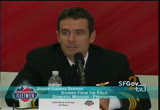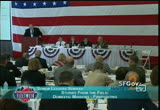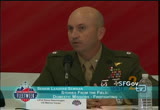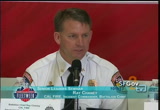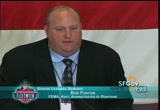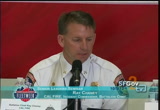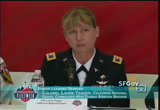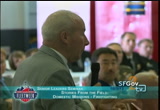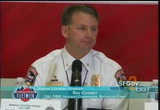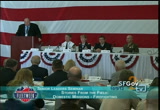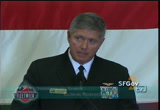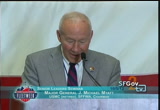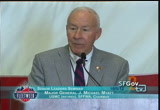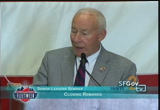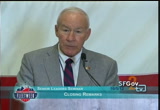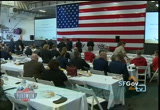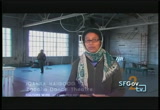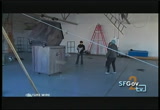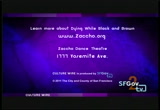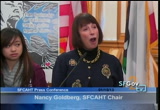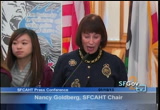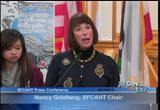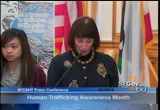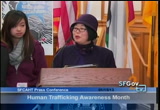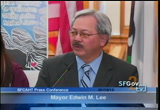tv [untitled] March 23, 2013 7:00am-7:30am PDT
7:00 am
fire fighting in 2006 but in 2007 was my first actual experience fighting fires and as i went in for my first dip in san diego to fill the bucket about two miles away was my brothers and my brother's house, his wife and my two nephews and that's when this capability really hit home for me, that it's an important thing. as was said before, every member -- we're all members of the community as well and it's all extremely important. the fire fight is important to us and we are ready and we count on the relationship that we have with cal fire. in fact, that's probably the most essential part of this thing for us to be ready to fight future fires. >> colonel. >> thank you very much for allowing us to come here and participate because it is important. we really appreciate very much this opportunity.
7:01 am
we're doing well right now but there's khal lefrpgs we can do better on and that's exactly what we're looking forward to do. we're looking forward to build upon and leverage what we're doing here. communications, that was one of the first things. it's different with our active duty forces because you see here, we send our aircraft all around the world. we can't necessarily just invest in some components in the aircraft and call it good because those assets may be gone and deployed but we have work arounds for that. we are looking forward to that as well in addition to the training. lastly is we again kind of relish the opportunity to participate in the operations against an active enemy. at least here, it's fire. we appreciate the fact we can go ahead and enter a tactical command air control. those are operations that are familiar to
7:02 am
us and they are, it's a great exercise for us tactically as well. we are able to integrate with cal fire itself with the objective being the fire itself. those work out for us here and we can go ahead and use those skills forward as well. thank you very much, we appreciate the opportunity. >> thank you, i'd like to thank our panelists and open it up to our group for any questions of our panelists today. yes, sir, secretary. >> there are a lot of things you can do in a forest that tend to make it easier it fight a fire like most importantly burning off the fuel during the wet season so there's less for the fire to feed on. to what extent in cal fire and all your other things do you encourage people to do things in their forest when you don't have a fire that make it easier and more effective in fighting the
7:03 am
fire? >> it's an excellent question, sir. we spend a large time in cal fire on public education and prevention and also with respect to you were talking about fuel, the fuels program, or vegetation management program in cal fire, we have a robust program throughout the state where we are conducting burning operations and vegetation management with prieflt ranch owners and private land owners as well as on state and cooperating with our federal agencies with the u.s. forest service. so two-fold program, vegetation management, we aggressively pursue that, but also from a public education stand point. what we find in these large scale incidents, the public is going to have to be self-sustaining and self-supporting. they need to be prepared. we try to educate them in respect that we say we'll provide the offense, you
7:04 am
provide the defense. we talk to them about hardening their structures in a defensive measure against wild land fires. a lot of it is public education, survivability, building standards, but predominately our focus is putting the onus on the land owner, putting the onus on the private property owner, we will attempt to protect your home but the days of staying and defending your home and killing our fire fighters are done. we will not stand and defend a house that has not been prepared by a land owner and die for it. we don't do that any more. that's one of our doctrinal changes and we set forth some new guidelines with that. >> thank you. >> question, mr. secretary. >> in a large scale disaster relief, where the military is called in to assist the civilian components there is an obvious issue of how you get the command and control and in
7:05 am
particular what telecommunications is used to support that command and control. your exercising together is very critical, i think, to working out command and control but you still have an equipment problem because the equipment, telecommunication equipment designed for the military was different from that used. how are you working out to get the coordination of telecommunications, particularly in disaster relief where the cellular infrastructure may be broken down and not available to support? could you comment somehow are you going to work out this telecommunications problem. >> so from a perspective of fema, we not only have a defense officer appointed by dod embedded with us during a disaster but we actually practice and have communications interoperatability over our systems to be sure we can communicate with each other on similar platforms and also support state and local platforms, whether it was
7:06 am
katrina or other events we've actually been able to bring in national guard platforms to provide 911 systems for cities that have lost those systems. we recently in the joplin tornados and also tuscaloosa tornados we brought in dod equipment to replace what was destroyed. from the fire side i know there's a lot of things you are doing to work around the interoperatability issues with regard to communications between fire and dod and maybe if ray or anybody else wants to speak to that. >> our communications challenges still exist. we have excellent telecom communications, we have a layered effect of our radio systems. we have mobile command posts that we can exercise. so we're prepared for power outages, reduction of telecoms, we have a layered
7:07 am
effect for our communications. but as everybody here said, we need help. if somebody here can help me get a navy or marine corps aircraft to talk to my guys on the ground tactically, i need that and i don't have that today. i use a command control helicopter, a civilian helicopter, to handle that and transfer that to an air to air victor frequency. but from a command control perspective, we're fairly robust. are we perfect, no, but we do have layered defenses against that. >> miss yeager, i don't know if you want to say anything from a national guard perspective. >> we have some mobile explorable platforms we can send out to incidents to help provide additional infrastructure in the event everything breaks down then our units have organic communications capability so i can move that out and i can
7:08 am
help reinforce cal fire on their incident with what i have in the aviation brigade and units through the state of california have that same communication but the iceu, which is a mobile communications platform, is ideal in events like this to push out to help. >> any other questions? >> i have one. back in 1992 when it was a big fire season and there was a lot of grass, they came to us and i was down at camp pendleton and they asked us it train marines on shovel work. what happened about 6 months later, they ended up sending two battalions to yellowstone. i haven't heard any discussion at all, do you expect the military, the guard or the active forces to be training people to do shovel-like work? all you have talked about so far is aviation. >> one of the challenges with a ground-based attack and
7:09 am
training a soldier to be a ground-based fire fighter is the training takes time. and it takes approximately 3 to 5 days of solid training to make sure that they are going to be working in a safe environment to learn what's going on. and most of the time that, the incidents in california will become mitigated. now, not to say that we certainly have that as an option. we have a fairly robust what we call fire crew program using cdcr inmate fire fighters. it is on our radar and it's something that we have as a contingency if we needed to do it. >> lieutenant colonel. >> yes, general, in the mou it does address the ground portion but the focus of effort is
7:10 am
mainly on the aviation side but it is built in there for the ground side if necessary. >> i just want to say in 2008 we did activate hand crews to fight fires and we've identified soldiers throughout the state to respond if needed. they've got the tools that they need, the boots and all that cached and available. it's really just a matter of getting the call and being ready to go. >> i was going to end with general myat. i know we've trained soldiers to do that kind of thing. after the colorado fires just recently they did put a lot of soldiers that trained, so we do still have that program who can do that if the need warrants. any other questions from out there before i turn it over to general myat? let me thank our panel here. >> thank you.
7:11 am
(applause). as we leave here today, we need to keep the ball moving forward. we can't -- i think most of us all here would agree, we really can't prevent the next disaster from happening. but by building the partnerships that we are here today and will continue to build in the future, we can certainly limit the number of deaths and long-term destruction. we can surge a lot of things: resources, people. but we cannot surge trust. so venues such as this is what helps us build that trust so that when the bell does go off we know --
7:12 am
a comment i made yesterday and i'd like to use it again in closing today, the most important thing for me to come out of this two-day seminar and sbat -- into the future is the ability for us to physically face to face look each other in the eye, shake hands and say to each other, we are in this together. thank you, ladies and gentlemen. . (applause). >> thank you, admiral beeman. you have helped me carry out one of the instructions secretary schultz gave to me 3 years ago, bring the fleet back to fleet week. we couldn't do it without you. i thank secretary and mrs. perry for coming, just -- i
7:13 am
know it's, you've got some other things, people are waiting on you right now but i really appreciate you coming here. of course secretary and mrs. schultz for the entire program. vice admiral nathan, i don't know if he's here, he may have gone already, but he gave a great talk yesterday on the medical side. and vice admiral z, coast guard, our senior rep here, i can never pronounce his name but he's made things great. general speese, thank you for making this happen. rear admiral hubner, he was here, he's been terrific working with us. rear admiral rivera coming up from the chilean navy, thank you so much. i learned a lot. we need the kind of input that we got from you, really, and we
7:14 am
thank you so much. i would be remiss not to mention the two people that really are responsible for all this. first was lewis loeven. lewis loeven works hours and hours to do this. thank you so much. but the other is because she's committed to make it happen and it's her focus that always to learn from everything that happens, ann koninberg at dem, thank you so much, ann, for everything you do. you had to have a pass to get on the ship. i've asked captain pringle, to get off the ship, i wonder if you can secure the hatch until they fill out their participant form. if you could do that, i would appreciate that.
7:15 am
fleet week, we are a neutral convener of the process to improve the relation ships between this global force for good and the local civilian officials. and one of our goals is next time you put up your slide with all those logos on it, general, you are going to have the san francisco fleet week logo on it, too. i look at what we accomplished in 2010, we had a meeting to understand dsca, in 2011 we had the table top exercise, we debriefed that, we had a great speaker then we had an education seminar. this time, this year we had a functional exercise in august which was terrific, you saw the panel, a medical exercise as part of fleet week and you saw the enthusiasm of the participants, then we had the back brief. now we've had a strategic operational and tactical discussions about going forward and the things that we can
7:16 am
accomplish. so what are you going to do in 2013? well, fill out the form and tell us what you think we ought to do but we're going to be working hard to move this forward. i think ray cheney said it from cal fire best today: we are all better off because we're in here for the last day and a half and i'm sitting here wondering, all my contemporaries, what have they been doing for the last 36 hours? they haven't been doing anything near as important as what we've been doing. i thank all of you so much for participating and stay in touch. if we've got your email address you will never be lonely because we're going to get you back here next year. thank you all so much. (applause).
7:17 am
7:18 am
better interesting to me, and then pursuing them. there are a lot of different artists that come here to work, mostly doing aerial work. kindred spirits, so to speak. there is a circus company that i have been fortunate enough to work with the last couple of years. i use elements of dance and choreography and combine that with theater techniques. a lot of the work is content- based, has a strong narrative. the dancers have more of a theatrical feel. i think we are best known for our specific work. in the last 15 years, spending a lot of time focusing on issues that affect us and are related to the african-american experience, here in the united
7:19 am
states. i had heard of marcus shelby and had been in join his work but never had the opportunity to meet him. we were brought together by the equal justice society specifically for this project. we were charged with beginning work. marquez and i spent a lot of time addressing our own position on the death penalty, our experiences with people who had been incarcerated, family members, friends of friends. pulling our information. beyond that, we did our own research. to create a picture that resonated with humanity. it is the shape of a house.
7:20 am
in this context, it is also small and acts like a cell. i thought that was an interesting play on how these people make these adjustments, half to create home. what is home for these people? the home is their cell. people talk a lot about noise -- very noisy in prisons. that is interesting to me. looking at the communication level, the rise of frustration of being caged, wondering, where does redemption fit into the equation here? [singing]
7:21 am
i think both of us really believe the death penalty is wrong, and is flawed for many reasons. the list is as long as my arm -- about several others. we feel this is important for both of us, personally, to participate in the debate of this issue in a way that we can help people frame it for a conversation. >> it's so great to see a full
7:22 am
house like this. it means the world to us and to the whole cause of anti-trafficking. we are waiting for mayor lee. my name is nancy goldberg, cochair of the seven cisco collaborative against human trafficking. i wanted to introduce my past chair, and my new cochair. when i tell people of my involvement their shock to hear that san francisco is in major definition of human trafficking. they think it is people from other parts of the world. there are also so many right here, from our own bay area communities.
7:23 am
in the city that is out of human trafficking we are also committed to being an agent of change. i want to give you a brief history of sf cat, san francisco collaborative against human trafficking. in response to what we saw is a growing problem, four organizations formed up in 2008, the jewish coalition against human trafficking; national council of jewish women, jewish reel fund, -- we then realize would needed a wider coalition in order to be more effective we reached out to a large variety of the government sectors. in february
7:24 am
2008 the jewish coalition held a conference against human trafficking which included agencies such as the san francisco commission on the status of women, representative of the mayor's office and other nonprofits. this event also attracted members of the state assembly and a few congressional offices. at a meeting following our conference a i was asked to chair the larger group and my condition was that there be a cochair from the mayor's office at that time was catherine dodd. the san francisco collaborative against human traffic was born. in 2010 - from the beginning emily morassie (sounds like)
7:25 am
executive director of the san francisco commission on the status of women was always involved as well as theresa sparks, executive director of the human rights commission. they were not only the core of the beginning but also generously offered to help us and support us and today that is where we are housed. we have a membership of over 28 agencies public and private representing a wide area of government agencies, law enforcement agencies, service providers, educators and community members. we are committed to ending human trafficking through collaboration, education, outreach, raising awareness and supporting survivors of human trafficking. how many cities have this kind of public private cooperation? i don't know but we are among the first and speaks about the
7:26 am
efforts put forth in the city but isn't this the city where all things that are impossible can happen? i wanted to just a few people who are here. first and foremost the honorable mayor ed lee. and supervisor carmen chu, has been a great champion. the winners of the sf cat annual poster concert and the keynote speaker, -- a human traffic survivor and advocate. i want to say that other human rights commissioners are here, -- and vice chair doug chen, -- commissioner, the president julie --
7:27 am
nancy kirshner rodriguez, police chief greg sur (sounds like) -- i will like to turn this over to mayor lee.diana are you here? he is on his way. well - thank you. why don't we do that? why waste a moment. >> nancy did mention that we will announce the winners of the fabulous poster contest. i am the executive director of commission on the status of women.
7:28 am
the mayor will be announcing not only the winners of the poster contest but also the winners of this year's abolitionist awards. fire commissioner -- is here and emily conroy from the department of justice is here. thank you for joining us. i want to bring up mayor lee so she can bring up the announcements of the honorees for today. apl(applause) >> thank you emily and thank you to the commission on the status of women to our human rights commission thank you for being here and the commissioners and staff as well. thank you police chief for being here and certainly all the other department heads. wendy thank you for being here as well. members of the community. advocacy groups that have been so important to this movement. supervisor carmen chu, i know you and mayor newsom had this
7:29 am
initial effort back some years ago to recognize the need to abolish human trafficking. an san francisco being such an international city, many of our roots are from immigrant families. we understand the problem. we did do something about it and continue that effort. i want to thank the us attorney's office for being here. and so many of you who have from the community done and continue to do what you can do to end human trafficking. this is such an important challenge for all of us. and because we here at from immigrant families; we hear from immigrant women and girls. the stories are real. they come across international borders. and so san fraco
68 Views
IN COLLECTIONS
SFGTV2: San Francisco Government Television Television Archive
Television Archive  Television Archive News Search Service
Television Archive News Search Service 
Uploaded by TV Archive on

 Live Music Archive
Live Music Archive Librivox Free Audio
Librivox Free Audio Metropolitan Museum
Metropolitan Museum Cleveland Museum of Art
Cleveland Museum of Art Internet Arcade
Internet Arcade Console Living Room
Console Living Room Books to Borrow
Books to Borrow Open Library
Open Library TV News
TV News Understanding 9/11
Understanding 9/11